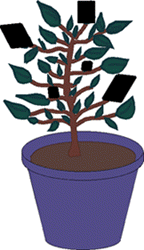
Recommended Age Group: Early Elementary, Later Elementary
1. Do plants need sunlight?
2. What happens if plants do not get sunlight?
Plants need sunlight (or the right kind and amount of electric light) in order to make chlorophyll.
Chlorophyll is the chemical that makes plants green.
Green plants need these things in order to use the energy from light in order to grow:
If plants do not get sunlight, they cannot produce chlorophyll and they will lose their green color and eventually die.
If plants lack any of the other things they need to grow, they will die.
Note that some plants are not green, although they do have chlorophyll. In colorful plants like coleus or purpleleaf plum, the chlorophyll’s color is masked or hidden by other pigments.
Room Preparation: Need to be able to put plants on a shelf or table where they get plenty of sunlight.
Safety Precautions: None
Ask the guiding questions:
Ask children to share ideas, facts or experiences to answer the first question, “Do plants need sunlight?” Don’t accept a simple “yes” or “no.”
Children will probably agree that plants need sunlight or they will die. Then deal with the second question, “What happens if plants do not get sunlight?” Share that in order for us to answer this question, we need to think and act like scientists. A scientist takes a question like this and then conducts an experiment to see what really happens and to gather data or facts.
Today, we will start an experiment that will take a week to conduct, to see if plants need sunlight and to see what happens to plants when they don’t get sunlight.
Give each pair or small group of 3—4 students a plant. Have them cut out of the black construction paper 4 square or oval pieces. Cover up 2 leaves on the healthy green plant with the black construction paper pieces, one on top of the leaf and one piece on the bottom of the leaf. Secure the papers on the leaf with paper clips.
Have students look at their leaves to make sure that the entire leaf area on top and on the bottom is covered up and won’t be able to get any sunlight.
After a week, remove the paper clips and pieces of black construction paper. What do the leaves look like? What color are they? What do you think happened?
Leave the plants on the windowsill or table top for another week. Water the plants when needed. Watch the leaves and see what happens to them when they are able to get sunlight again. What causes them to turn green again?
Ask again:
Listen as children discuss their experiment, what they observed, and draw conclusions on what they think happened to leaves when they were covered up and then uncovered. Encourage them to use terms including sunlight, energy, chlorophyll, and experiment.
If possible, let them help another group conduct this experiment. You can really see if they understand the concepts when they teach someone else!
An alert reader has noted that this lesson is over-simplified for children. Note that “This is not a conclusive experiment to show that plants require light. Covering the bottom of the leaf may prevent carbon dioxide from entering the leaf stomata, which will prevent photosynthesis even with adequate light.” Putting the entire plant in a dark closet would be a more definitive experiment.
Some may be interested in learning more about chlorophyll and photosynthesis. Encourage them to do some research and gather information to share with others. The article “Avoid Misconceptions when Teaching about Plants,” by the reader referred to above, is a detailed and comprehensive source.
Another fun and easy experiment is to take a shoe box or other cardboard box cover and put it on top of a very green grassy area. Put a rock on top of the box so it stays put. Every day for a week, take a quick peek to see what is happening to the grass under the box. After a week, look at the grass and see if there are similarities between it and the leaves we experimented with. Watch the grass for another week to see if it turns green again and how quickly it happens.
| Let us know what you think! E-mail our webmaster |
Are you happy with your life?Michigan Reach Out! has distilled our best mentor training into a book, Passport 2 Purpose. Let us help you answer the important questions determining whether you will enjoy your life's journey! | |
| To Lessons by Subject or Age Group | ||
| To Alphabetical Listing | ||
| To Michigan Reach Out! Home |